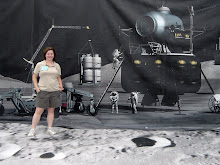Monday, February 13, 2006
Home Plate
We’ve finally made it through part one of our race against winter, to the feature called “Home Plate” in the inner basin. Wild theories of its origin abound - everyone is getting in on the speculative volcanology. We’re now parked perilously up against an outcrop on the outer ring of Home Plate and doing a very nice campaign bringing all our instruments to bear. Keep an eye on the JPL home page for details of what we find!
Yet more training
This week I spent a couple of days at the Johnson Space Center in Houston learning the ins and outs of two of our arm instruments – the Alpha Proton X-ray Spectrometer (APXS) and the Moessbauer spectrometer (MB). These two instruments give us detailed, quantitative information on the major-element chemistry (APXS) and mineralogy of the iron-bearing phases (MB) in the rocks, and are the two instruments that I’m most interested in for my work. So, as one of my operational roles, I wanted to learn more about how they work and how we make them work.
Both the APXS and the MB were designed and developed by German teams as contributions to the MER mission, and they are led by the Payload Element Lead scientists in other countries. They are the ones who know the real ins and outs of these instruments. But, in the current mode of remote operations, two people at JSC know an awful lot about the day-to-day operation of the instruments, and Houston is a lot easier to get to than Germany.
These three days were really rewarding for me. Days like that are the ones that keep me going through the slump months. It was the busiest couple of days on both rovers that we could have asked for, as both were using their arm instruments on interesting outcrops. I got to see lots of friends and meet new colleagues, learn something really interesting that only a few people in the world can do, feel confident that I can do it well, and talk about the science with a collegial bunch of planetary scientists. As an extra bonus, while there, I also got to see the Stardust samples making tracks through their aerogel collectors, just a few weeks after their return from Comet Wild/2.
Both the APXS and the MB were designed and developed by German teams as contributions to the MER mission, and they are led by the Payload Element Lead scientists in other countries. They are the ones who know the real ins and outs of these instruments. But, in the current mode of remote operations, two people at JSC know an awful lot about the day-to-day operation of the instruments, and Houston is a lot easier to get to than Germany.
These three days were really rewarding for me. Days like that are the ones that keep me going through the slump months. It was the busiest couple of days on both rovers that we could have asked for, as both were using their arm instruments on interesting outcrops. I got to see lots of friends and meet new colleagues, learn something really interesting that only a few people in the world can do, feel confident that I can do it well, and talk about the science with a collegial bunch of planetary scientists. As an extra bonus, while there, I also got to see the Stardust samples making tracks through their aerogel collectors, just a few weeks after their return from Comet Wild/2.
Friday, February 03, 2006
The Earth's a planet too
When I first joined the Athena team, I went out to dinner with my fellow New Mexican, Larry Crumpler. He said something that stuck with me - that the value of planetary geology is what you gain in being able to see the Earth differently, and hopefully, better. I'm finding myself looking around me all the time and asking, "How would the rovers see this?" It's especially true now that we're rounding third and heading for "Home Plate," a mysterious feature that could be a crater, a salt pan, a lava flow, or come combination of all three.
On my commute home every evening, I head up La Bajada hill, an abrupt fault face capped with spectacular columnarly jointed basalts of the Caja del Rio field, where I live. It's usually getting on dark when I creep up the hill, but this week I happened home early and saw my passage through the tumbling basalt boulders, steep arroyos, and deep red soils. I really paid attention to the illumination, the relationships between boulders and layers, to what I saw and what my brain filled in as "normal." It was one of those great moments when I'm so happy with my own brain. Then, later in the evening, it got dark and there was Mars itself, a shining orange point.
On my commute home every evening, I head up La Bajada hill, an abrupt fault face capped with spectacular columnarly jointed basalts of the Caja del Rio field, where I live. It's usually getting on dark when I creep up the hill, but this week I happened home early and saw my passage through the tumbling basalt boulders, steep arroyos, and deep red soils. I really paid attention to the illumination, the relationships between boulders and layers, to what I saw and what my brain filled in as "normal." It was one of those great moments when I'm so happy with my own brain. Then, later in the evening, it got dark and there was Mars itself, a shining orange point.
Subscribe to:
Posts (Atom)
